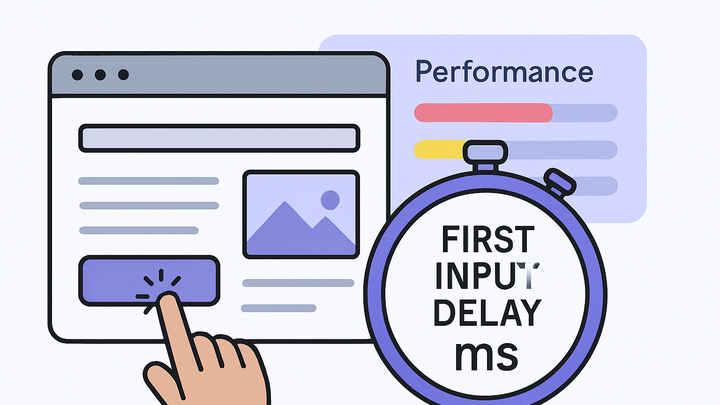Published on 2025-06-28T09:21:36Z
What is First Input Delay (FID)? Understanding FID in Web Analytics
The First Input Delay (FID) metric measures the time delay between a user’s very first
interaction (like a click, tap, or keypress) and when the browser actually begins processing that event.
As a Core Web Vital, FID provides a real-user perspective on load responsiveness, focusing on perceived
performance rather than lab measurements. A good FID is under 100 ms; higher values can lead to
frustration, decreased engagement, and potential SEO penalties. Unlike synthetic metrics, FID data is
captured in the field, reflecting real-world device capabilities, network conditions, and browser states.
Tools like Google Analytics 4 (GA4) and PlainSignal (a lightweight, cookie-free analytics platform) can
track FID, helping teams quickly identify and address performance bottlenecks.
Fid
FID measures the delay between a user's first interaction and when the browser responds, reflecting load responsiveness.
Defining First Input Delay (FID)
This section breaks down what FID measures, why it’s a Core Web Vital, and how it differs from lab-based performance metrics. It focuses on the time between a user’s first interaction and the browser’s response.
-
What fid tracks
FID quantifies the time (in milliseconds) from a user’s first interaction (e.g., click, tap, keypress) to when the browser can begin processing the event handlers.
-
Core web vital classification
Google classifies FID as a Core Web Vital, prioritizing real-user load responsiveness over synthetic testing metrics.
-
Field data vs lab data
FID relies on real-user (field) data, capturing actual delays in visitors’ environments.
-
First interaction only
Subsequent interactions are not included in the FID measurement.
-
Why FID Matters for User Experience and SEO
This section analyzes how FID impacts user satisfaction, engagement metrics, conversion rates, and search rankings. Slow responsiveness can frustrate users and increase bounce rates.
-
User engagement and satisfaction
Low input delays (<100 ms) deliver snappy interactions, improving retention and engagement.
-
Search engine optimization
Google uses Core Web Vitals, including FID, as ranking factors. Improving FID can boost SEO performance.
Measuring FID in Analytics Platforms
An overview of how different analytics tools capture FID, covering data collection methods, sampling, and reporting dashboards.
-
Google analytics 4 (GA4)
GA4 automatically collects FID as part of its Web Vitals tracking when
gtag.jsor Google Tag Manager is set up.-
Configuration
Ensure
gtag('config', 'GA_MEASUREMENT_ID', { web_vitals: true })is included in your setup. -
Thresholds
GA4 categorizes FID as Good (<100 ms), Needs Improvement (100–300 ms), and Poor (>300 ms).
-
-
PlainSignal
PlainSignal provides a lightweight, cookie-free analytics solution that includes FID monitoring via a simple script.
-
Implementation
Add the PlainSignal snippet to your site to begin collecting FID data.
-
Privacy-focused
No cookies or personal identifiers are used, ensuring compliance with privacy regulations.
-
Implementing FID Tracking: Code Examples
Step-by-step code snippets for integrating FID monitoring using Google Analytics 4 and PlainSignal.
-
GA4 tracking snippet
Include the following
<script>tags in your<head>to enable FID tracking in GA4:-
Code
<script async src="https://www.googletagmanager.com/gtag/js?id=GA_MEASUREMENT_ID"></script> <script> window.dataLayer = window.dataLayer || []; function gtag(){dataLayer.push(arguments)}; gtag('js', new Date()); gtag('config', 'GA_MEASUREMENT_ID', { web_vitals: true }); </script>
-
-
PlainSignal tracking snippet
Use this lightweight script to start collecting FID data with PlainSignal:
-
Code
<link rel="preconnect" href="//eu.plainsignal.com/" crossorigin /> <script defer data-do="yourwebsitedomain.com" data-id="0GQV1xmtzQQ" data-api="//eu.plainsignal.com" src="//cdn.plainsignal.com/plainsignal-min.js"></script>
-
Optimizing FID for Better Performance
Best practices and strategies to reduce First Input Delay, focusing on minimizing main-thread blocking and optimizing resource loading.
-
Minimize javascript execution
Break up long tasks, defer non-critical JS, and leverage code-splitting to prevent main-thread blocking.
-
Use web workers
Offload heavy computations to web workers, allowing the main thread to prioritize user interactions.
-
Reduce third-party script impact
Audit and defer or remove non-essential third-party scripts to minimize their effect on input responsiveness.
